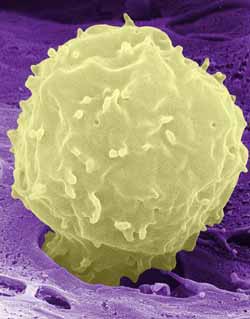White blood cells mediate insulin resistance

This is a false-colored, scanning electron micrograph of a neutrophil.<br><br>Credit: UC San Diego School of Medicine<br>
Researchers at the University of California, San Diego School of Medicine say neutrophils, an abundant type of white blood cell typically tasked with attacking bacteria and other foreign invaders, also plays an unexpected role in mediating insulin resistance – the central characteristic of type 2 diabetes, which afflicts an estimated 26 million Americans.
The findings are published in the August 5, 2012 Advance Online Publication of Nature Medicine.
Neutrophils are the first immune cells to respond to tissue inflammation, and can promote chronic inflammation by summoning other white blood cells called macrophages. Chronic low-grade inflammation – common in adipose or fat tissue – is an important cause of systemic insulin resistance.
Using liver and fat cells from mice and humans and live mouse models, a team led by Jerrold M. Olefsky, MD, associate dean for scientific affairs at UC San Diego Health Sciences and professor of medicine, discovered that an enzyme secreted by neutrophils called neutrophil elastase (NE) impairs insulin signaling and boosts resistance. Conversely, deletion of NE in obese mice fed a high-fat diet improved insulin sensitivity.
“These results are largely unexpected,” said Da Young Oh, an assistant project scientist in Olefsky's lab and study co-author. “Although several immune cells have been established in the etiology of insulin resistance, the role of neutrophils in this process has remained unclear until now.”
Oh said neutrophils were considered to be “transient infiltrates,” temporary cells (average lifespan: 5 days) that were incapable of sustaining chronic, low-grade inflammation. “Our studies now suggest neutrophils possess powerful immune modulatory effects,” Oh said.
Specifically, neutrophils use NE to activate a signaling pathway which triggers pathogen-eating macrophages to secrete proinflammatory molecules called cytokines. NE degrades IRS1, a key protein in the insulin signaling pathway in both liver and fat cells. Although NE has been shown to degrade this protein in lung cancer cells, the scientists said, the effect on insulin target tissues such as liver and adipose is striking.
The insulin-mediating role of neutrophils makes them a new target for developing treatments of insulin resistance in particular and diabetes in general. “Given that NE mediates insulin resistance, one could, in theory, take an NE activity inhibitory approach to reverse or improve insulin resistance,” Oh said, noting that NE inhibitors are already used for treatment of emphysema in Japan and are being tested in the United States, both for emphysema and type 1 diabetes.
Co-authors are Saswata Talukdar, Gautan Bandyopadhyay, Jianfeng Xu, Joanne McNelis, Min Lu, Pingping Li, Jachelle Ofrecio and Michael Lin, Department of Medicine, UCSD; Dongmei Li, Qingyun Yan, Yimin Zhu and Martin B. Brenner, Pfizer.
Funding for this research came, in part, from the National Institutes of Health (grants DK033651, DK074868, T32 DK007494, DK090962, and DK063491) and the Eunice Kennedy Shriver NICHD/NIH agreement (U54 HD 012303-25), part of the specialized Cooperative Centers Program in Reproduction and Infertility Research.
Media Contact
More Information:
http://www.ucsd.eduAll latest news from the category: Health and Medicine
This subject area encompasses research and studies in the field of human medicine.
Among the wide-ranging list of topics covered here are anesthesiology, anatomy, surgery, human genetics, hygiene and environmental medicine, internal medicine, neurology, pharmacology, physiology, urology and dental medicine.
Newest articles

Superradiant atoms could push the boundaries of how precisely time can be measured
Superradiant atoms can help us measure time more precisely than ever. In a new study, researchers from the University of Copenhagen present a new method for measuring the time interval,…

Ion thermoelectric conversion devices for near room temperature
The electrode sheet of the thermoelectric device consists of ionic hydrogel, which is sandwiched between the electrodes to form, and the Prussian blue on the electrode undergoes a redox reaction…

Zap Energy achieves 37-million-degree temperatures in a compact device
New publication reports record electron temperatures for a small-scale, sheared-flow-stabilized Z-pinch fusion device. In the nine decades since humans first produced fusion reactions, only a few fusion technologies have demonstrated…





















